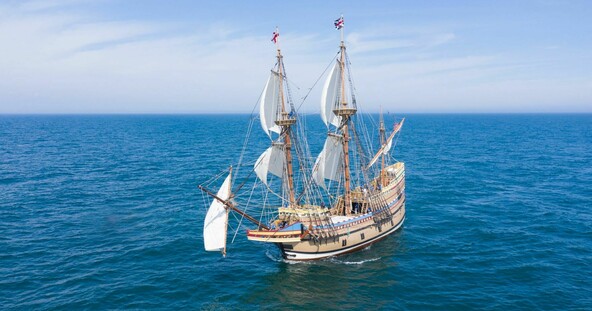
- Plan Your Visit
- Explore Our Sites

Mayflower II
All Aboard Mayflower II ! Along with national treasures such as the Statue of Liberty and the Lincoln Memorial, Mayflower is an iconic symbol of freedom. Of the hundreds of ships that made the transatlantic crossing in the 1600s, she is the ship we remember. Three hundred years later, on June 13, 1957, a full-scale reproduction arrived in Plymouth Harbor, Mayflower II .
Since then, Mayflower II has become the majestic centerpiece of historic Plymouth Harbor, and the Commonwealth of Massachusetts. In many ways, America is the product of the events that happened in Plymouth and Native Patuxet over four centuries ago—the choices made, risks taken, and the adaptation of community structures to new civic realities. Mayflower II tangibly embodies those choices and risks for hundreds of thousands of lifelong learners each year. More than twenty-five million people have stepped aboard her decks to imagine the perils and contemplate the modern impacts of the historic crossing.
Today, Mayflower II is a floating classroom and working vessel. Following her restoration and return to Plymouth in 2020, she was added to the National Register of Historic Places, illuminating that she is a historic ship in her own right.
"Like most people, I was immediately struck by how small the ship seemed - particularly in the 'tween decks, where the passengers were confined. How could 102 people, including three pregnant mothers, have survived more than ten weeks in a space this size?"—Nathaniel Philbrick, "At Sea with the Pilgrims: Writing About the Voyage of the Mayflower, " Plimoth Life, 2007.
Frequently Asked Questions
Mayflower is a square-rigged vessel that is about 25 feet wide and 106 feet long, displacing 236 tons of water. She has four masts, including a mainmast, foremast, mizzen, and sprit, with a total of six sails. You may walk around the main deck, orlop deck, and half deck.
Mayflower is not fully accessible. People with difficulty walking should be aware that there are ramps that can be steep according to the rise and fall of the tides. On the ship, there are also several flights of stairs to climb. However, those unable to board the ship may enjoy a close-up view of Mayflower from the dock, visit the dockside exhibit area, talk to modern crewmembers, and look at photographs of the interior of the ship.
Yes, we encourage you to take photographs or use video cameras for your own use. You need not ask permission of the staff to take pictures of Mayflower . Commercial use of photographs or video is prohibited without permission from our Public Relations office.
No one knows for sure what happened to the original Mayflower . The last record of the ship was an assessment of her value in 1624. After that, she disappeared from maritime records. Several places in England claim to have a piece of the original ship, but there is no historical proof to support these claims.
Mayflower passengers lived on board anywhere from seven to nine months depending on when they joined the voyage and how soon they left the ship for shelter on land.
One of the most notable differences is the large modern staircase between the main deck and the lower decks. (In the 17th century, ladders were used). Electric lights illuminating the dark corners of the lower deck were also not standard in the 1600s! There were other minor modifications made to Mayflower to make sure that she would be more accessible, safe, and comfortable for the visiting public.
Mayflower II : Her Story
Under construction.
A reproduction ship was always part of Harry Hornblower’s vision for Plimoth Patuxet Museums (learn more about his vision here). In 1951 Plimoth Patuxet (then known as Plimoth Plantation) contracted naval architect, William A. Baker, to research and design plans for a ship the size and type of the original Mayflower. At nearly the same time, unbeknownst to Plimoth Patuxet, a similar project was developing in England. Warwick Charlton founded Project Mayflower Ltd. to honor the alliance of friendship forged between the United States and United Kingdom during World War II. Charlton’s team came across an article written by Baker, and after connecting with Plimoth Patuxet, a new partnership was born. Plimoth Patuxet provided Baker’s research and plans to Project Mayflower Ltd. Of course, that is just the start of Mayflower II’ s journey!
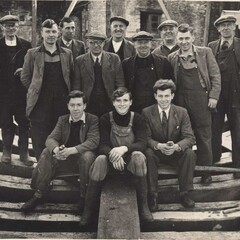
[ Above Photo Captions: Photo 1: Generations of shipwrights on Mayflower II’s frame at the J.W. & A. Upham Shipyard; Photo 2: A shipwright works in the hull of Mayflower II . Note the “Mayflower” banner flown between a United States and United Kingdom flag; Photo 3. Shipwrights, community members, dignitaries, and project leaders gather for the keel laying ceremony in July 1955. Note the United Kingdom and American flags tied together above the bean in tribute to the friendship between the two countries the ship exemplified following World War II; Photo 4: A shipwright works on Mayflower II using traditional 17th-century methods and tools. Photo 5: View of Mayflower II’s Main deck and Beak; Photo 6: Mayflower II , nearing completion and being rigged by shipwrights in Brixham. ]
Her Maiden Voyage
Mayflower II set sail from Plymouth, England on April 20, 1957 with a crew of thirty-three men under the command of acclaimed Captain Alan Villiers. As they neared Massachusetts shores, Mayflower II ran into a violent squall. No one aboard had experience with handling a 17th-century vessel in inclement weather. However, Captain Villiers remembered that William Bradford, famed Governor of Plymouth Colony and passenger aboard the original Mayflower during her 1620 voyage, wrote in his manuscript, Of Plimoth Plantation , how Master Christopher Jones steered the original ship to safety during the 1620 voyage by lying ahull. Quickly recalling this note, Villiers and the crew executed the same maneuvers and calmly rode out the storm. On June 13, 1957 Mayflower II arrived in Plymouth, Massachusetts to a crowd of 25,000 adoring spectators.
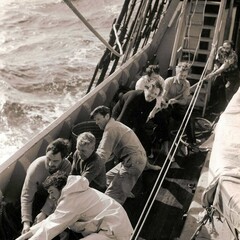
[Above Photo Captions: Photo 1: Stuart Upham, second from rear, hauls a line with fellow Mayflower II crew members in 1957; Photo 2: Mayflower II undersail in the Atlantic Ocean; Photo 3: A selection of images of the crew aboard Mayflower II during her 1957 maiden voyage. Top right, a batch of rolls fresh out of the oven in Mayflower II ’s galley. Top left, crew members demonstrate 17th-century medical procedures with leeches while under sail. Bottom right, Captain Villiers delivers a Sunday service to the crew. Bottom left, a crew member sketches and paints; Photo 4: A selection of images from the 1957 voyage. Top right, crew members dressed in Pilgrim attire on the Main deck. Top left, Captain Villiers, in Pilgrim attire, addresses his crew on the Main deck. Bottom right, a crew member at the ship’s wheel during the day. Bottom left, a crew member at the ship’s wheel at night; Photo 5: The 1957 Mayflower II crew with Captain Villiers; Photo 6: Mayflower II arrives in Plymouth on June 13, 1957 and is greeted by thousands of spectators along the waterfront. ]
Her Triumphant Restoration
“ Mayflower II is a source of inspiration to those in search of new beginnings and the possibility of multicultural cooperation in this nation of immigrants. Upon her return to Plymouth Harbor she once again became a kind of time machine…to a past that only gains in resonance and importance with each passing day.”—Nathaniel Philbrick
After 3+ years of restoration and 3 weeks of sea trials, on August 10, 2020 Mayflower II departed a slip at Mass Maritime Academy headed for home. With great fanfare and a flotilla along the way, the ship nestled back into her berth in Plymouth Harbor later that day.
Following her return, on October 22, 2020 Mayflower II was named to the National Register of Historic Places. She was deemed historically significant for her association with the founding story of the United States and as a full-scale ship that embodies the distinctive characteristics of a 17th-century English merchant vessel. In April 2021, Mayflower II received a Paul & Niki Tsongas Award from Preservation Massachusetts in recognition of the project’s significant work in historic ship restoration, and went on to win Preservation Massachusetts’s People Choice Award the following month.
[All photos in the below gallery are from Mayflower II ’s August 2020 homecoming following her restoration.]
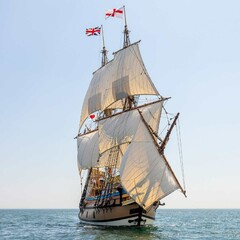
Mayflower II Museum Shop Merch
Shop exclusive Mayflower II merchandise from the Plimoth Patuxet Museum Shops! From jewelry made from wood salvaged during the ship’s restoration to apparel, children’s books, and art, the decks are stocked with a bounty of exclusive goods. Shopping Mayflower II ’s merchandise is a wonderful way to fill her sails and support her educational mission!
Shop exclusive Mayflower II merchandise
- History Classics
- Your Profile
- Find History on Facebook (Opens in a new window)
- Find History on Twitter (Opens in a new window)
- Find History on YouTube (Opens in a new window)
- Find History on Instagram (Opens in a new window)
- Find History on TikTok (Opens in a new window)
- This Day In History
- History Podcasts
- History Vault
The Pilgrims’ Miserable Journey Aboard the Mayflower
By: Dave Roos
Updated: September 6, 2023 | Original: November 18, 2020

Sailing for more than two months across 3,000 miles of open ocean, the 102 passengers of the Mayflower—including three pregnant women and more than a dozen children—were squeezed below decks in crowded, cold and damp conditions, suffering crippling bouts of seasickness, and surviving on meager rations of hardtack biscuits, dried meat and beer.
“The boat would have been rolling like a pig,” says Conrad Humphreys , a professional sailor and skipper for a recreated sea journey of Captain William Bligh. “The smell and stench of illness and sickness down below, and the freezing cold on deck in the elements, it would have been pretty miserable.”
The Mayflower , like other 17th-century merchant ships, was a cargo vessel designed to haul lumber, fish and casks of French wine—not passengers. The 41 Pilgrims and 61 “strangers” (non-Separatists brought along as skilled craftsmen and indentured servants) who boarded the Mayflower in 1620 made for unusual cargo, and their destination was no less foreign. The ship’s square rigging and high, castle-like compartments were suited for short hops along the European coastline, but the Mayflower’s bulky design was a handicap for sailing against the strong Westerly winds of the North Atlantic.
“The journey would have been painfully slow with many days of being blown backward rather than forward,” says Humphreys.
Incredibly, though, all but one of the Mayflower’s passengers survived the grueling, 66-day ordeal, and the Pilgrims even welcomed the arrival of a newborn baby halfway through the journey, a boy aptly named Oceanus. The Pilgrims’ joy and relief on catching sight of Cape Cod on the morning of November 9, 1620 was recorded by their leader William Bradford in Of Plymouth Plantation .
“Being thus arrived in a good harbor and brought safe to land, they fell upon their knees and blessed the God of heaven, who had brought them over the vast and furious ocean, and delivered them from all the perils and miseries thereof," wrote Bradford.
From Two Ships to One

The Pilgrim’s arduous journey to the New World technically began on July 22, 1620, when a large group of colonists boarded a ship called the Speedwell in the Dutch port city of Delfshaven. From there, they sailed to Southampton, UK, where they met the rest of the passengers as well as a second ship, the Mayflower. The two ships disembarked from Southampton on August 6 with hopes of speedy crossing to northern Virginia.
But just hours into the journey, the Speedwell began to leak badly, and the two ships were forced to pull in at Dartmouth. The Speedwell was finally ready to sail again on August 24, but this time only made it 300 miles before springing another leak. The frustrated and exhausted Pilgrims docked at Plymouth and made the difficult decision to ditch the Speedwell. Some of the Pilgrims also called it quits in Plymouth, but the rest of the passengers and cargo from the Speedwell were transferred to the already overcrowded Mayflower.
The traditional account of the Mayflower journey begins on September 6, 1620, the day it sailed from Plymouth, but it’s worth noting that by that point the Pilgrims had already been living aboard ships for nearly a month and a half.
Life on the Gun Deck

The Mayflower was about 100 feet long from stem to stern and just 24 feet wide. In addition to its 102 passengers, the Mayflower carried a crew of 37 men—sailors, cooks, carpenters, surgeons and officers. The crew was housed in small cabins above the main deck, while the Pilgrims were consigned to the “gun deck” or “between decks,” a suffocating, windowless space between the main deck and the cargo hold below.
“These lower decks were very cramped, cold and wet, with low ceilings no more than five feet tall,” says Humphreys. “And all around you, people are getting seasick. It’s really not a very nice place to be.”
The passengers shared the gun deck with a 30-foot sailboat called a “shallop” that was stored below decks until their arrival in the New World. Between the masts, storage rooms and the shallop, the total available living space for 102 people measured only 58 feet by 24 feet. The passengers practically slept on top of each other, with families erecting small wooden dividers and hanging curtains for a semblance of privacy.
“The crew would occasionally let some of the passengers up on deck to get some fresh air, but on the whole, the Pilgrims were treated like cargo,” says Humphreys. “The crew were worried about people being swept overboard. The journey was difficult enough for seasoned sailors, nevermind novices like the Pilgrims.”
Biscuits and Beer
Mealtime on the Mayflower brought little to celebrate. The cooks would have run out of fresh food just days into the journey and instead relied on salted pork, dried fish and other preserved meats. Since regular bread would spoil too quickly, they served hardtack biscuits, jaw-breaking bricks made from flour, water and salt.
“The beverage of choice for many of these old voyages was beer,” says Humphreys, explaining that casks of fresh water tended to go “off” during long storage. “Even young children were given beer to drink.”
Subsisting on small rations of salted meats and beer, the Pilgrims would have been malnourished, dehydrated, weak and susceptible to scurvy. When Humphreys recreated Bligh’s 60-day crossing of the South Pacific, he and his crew ate only 18th-century rations—about 400 calories per person per day—and each man lost 25 percent of their body weight.
Stormy Weather and the 'Great Iron Screw'
Bradford’s short description in Of Plymouth Plantation of life aboard the Mayflower is the only surviving account of the crossing, but it includes enough harrowing details to understand how close the journey came to disaster.
After a month of relatively calm seas and smooth sailing, the Mayflower encountered the first of an unrelenting series of North Atlantic storms that buffeted and battered the ship for weeks. The crew was forced on several occasions to lower the sails and let the Mayflower bob helplessly in the towering waves.
“They were encountered many times with cross winds and met with many fierce storms with which the ship was shroudly shaken, and her upper works made very leaky,” wrote Bradford, “and one of the beams in the midships was bowed and cracked, which put them in some fear that the ship could not be able to perform the voyage.”
Whether Bradford was talking about a cracked mast or another type of wooden beam is unclear, but the damage was serious enough for the Pilgrims to call a meeting with the captain to discuss turning back. But then something remarkable happened.
“…There was a great iron screw the passengers brought out of Holland, which would raise the beam into his place,” wrote Bradford, describing an object that was either the screw of a printing press or a large jack to raise the roof of a house. Either way, it worked, and the Pilgrims “committed themselves to the will of God and resolved to proceed.”
An Unexpected Swim
During one of those brutal storms, when the Mayflower was forced to draw its sails and “hull for divers days,” one of the passengers apparently became desperate for a breath of fresh air. Bradford wrote that a “lusty young man” named John Howland wandered onto the main deck and “with a seele [or pitch] of the ship [was] thrown into the sea.”
By some miracle, Howland was able to grab hold of the halyards hanging overboard and hold on for dear life, “though he was sundry fathoms under water,” wrote Bradford. Working quickly, the crew pulled Howland close enough to the ship to snag him with a hook and haul the foolhardy young man back onto the deck. Bradford proudly reported that after a short sickness, Howland not only recovered, but “lived many years after, and became a profitable member both in church and commonwealth.”
The Death of William Butten, the First of Many

Bradford makes only passing mention of the one death on the Mayflower. A young boy named William Butten, an indentured servant to one of the Pilgrims, fell ill during the journey and died just a few days shy of reaching the New World.
Given the dangers of the journey and the rough conditions aboard the Mayflower, it was a miracle that only one person out of 102 perished on the 66-day voyage. Sadly, the Pilgrims’ fortunes changed for the worse once they landed at Cape Cod in early November. The passengers and crew continued to live on the Mayflower for months as permanent dwellings were constructed on the shore.
With each passing week, more and more Pilgrims and their “stranger” companions succumbed to bitter cold and disease. By spring 1621, roughly half of the Mayflower’s original passengers had died in their new home. Among them was little Oceanus. In one piece of good news, another baby named Peregrine, the first Pilgrim baby born in the Plymouth Colony , not only survived the brutal winter, but lived on for more than 80 years.

HISTORY Vault: Lost Colony Of Roanoke
In 1590, the settlers of Roanoke—the first English colony in the New World—were discovered to be missing. The only clues: five buried chests and the word "Croatoan," a Native American village nearby, carved on a post. Archaeologists search for answers.

Sign up for Inside History
Get HISTORY’s most fascinating stories delivered to your inbox three times a week.
By submitting your information, you agree to receive emails from HISTORY and A+E Networks. You can opt out at any time. You must be 16 years or older and a resident of the United States.
More details : Privacy Notice | Terms of Use | Contact Us

Mayflower400 partner destinations:
The Mayflower Voyage
For the passengers and crew who boarded the Mayflower some four centuries ago, the odds were firmly stacked against them as they looked to cross the Atlantic to start a new life .
By the time the group set sail from Plymouth on 16 September 1620, many of them had experienced religious persecution; trouble with the law (including time in prison for some); betrayal from those they trusted; numerous stops in ports around the country, and the eventual demise of the Mayflower’s sister ship, the Speedwell.
Little did they know, their hardships would only get worse during a voyage which saw emergency repairs, disease, death and even the birth of a new child.
Below you can read stories about the Mayflower’s historic journey, and how the colonists finally reached North America after 66 gruelling days at sea.
The Mayflower Story
The Mayflower set sail on 16 September 1620 from Plymouth, UK, to start its long voyage to America.
But its history and story start long before that in the villages, towns and cities of England.
Mayflower – The journey to 16 September
The Mayflower eventually set sail from Plymouth, UK, on 16 September 1620 to start what would prove to be a treacherous transatlantic voyage to America.
This is the fascinating story of how the colonists made the trip possible, and the events that led to them gathering on the water’s edge in Devon some 400 years ago.
How the Mayflower prepared for its historic transatlantic voyage
As with any long trip, preparation is key - and the colonists had spent many months leading up to their departure gathering provisions and supplies that would last them during their voyage and beyond.
One can only image how cramped and crowded conditions would have been on the Mayflower with more than 100 passengers on board and provisions to match.

66 days at sea: What life was like on board the Mayflower
The odds were firmly stacked against the passengers and crew who boarded the Mayflower some four centuries ago in a bid to start a new life across the Atlantic.
Little did the group know, their hardships would only get worse during a voyage which saw emergency repairs, disease, death and even the birth of a new child.
The Mayflower Compact
With America almost close enough to touch, the battered and broken Mayflower passengers knew their journey was far from over, for they had no right to settle on the land upon which they had unintentionally arrived.
The Pilgrims anchored in what is now Provincetown Harbour, Massachusetts, and decided to draw up an agreement that would give them some attempt at legal standing.
Millions owe their lives to Mayflower passenger who fell overboard
As if the colonists' perilous transatlantic crossing wasn't harrowing enough, imagine how frightened John Howland must have been when he fell overboard as a storm of epic proportions battered the Mayflower?
Howland was thrown overboard during nightmare sea conditions but managed to grab hold of a trailing rope, giving the Mayflower crew just enough time to rescue him with a boat-hook.
The Boy Who Fell From The Mayflower
The Boy Who Fell From The Mayflower (Or John Howland’s Good Fortune) is a beautifully illustrated children’s book that tells the imagined story of a real-life passenger aboard the pioneering ship.
John Howland was a teenager in 1620 when he sailed to America as an indentured servant. His story and the Mayflower’s dramatic voyage from Plymouth is vividly brought to life by writer and illustrator P.J. Lynch.
What happened after the Mayflower landed in America?
After more than two months battling everything the Atlantic had to throw at them, the Mayflower passengers' horrific ordeal was far from over.
What lay ahead were many more months of trials and tribulations which would test their spirit and, ultimately, decimate their numbers as they lost family, friends and loved ones to disease and the elements.
The unbreakable bond of the original Mayflower passengers who survived their first winter in America
Shared pain is undoubtedly one of the most powerful factors in bringing people together.
So, it’s no surprise that those who reached America in November 1620 and survived the subsequent first harsh winter had shared an experience that no other European could possibly understand.
How the Mayflower passengers started to build a colony
The Mayflower passengers and crew reached the coast of America during a harsh winter which brought with it heavy snow.
Conditions made it incredibly difficult, but the group put together three exploring parties over the course of the month between the middle of November and the middle of December.
Who were the children of the Mayflower?
Little is known about the children who sailed on the Mayflower some 400 years ago, but it is thought that there were around 30 on board the ship when the group departed Plymouth.
Richard Pickering, Deputy Director of Plimoth Patuxet Living Museum, explores more about the children of the Mayflower.
Sign up for the latest Mayflower 400 news
You'll be the first to hear the latest Mayflower news, events, and more.
Forgotten Password?
Mayflower 400 Proudly Supported by our National Sponsors and Funding Partners

- Website Privacy Policy
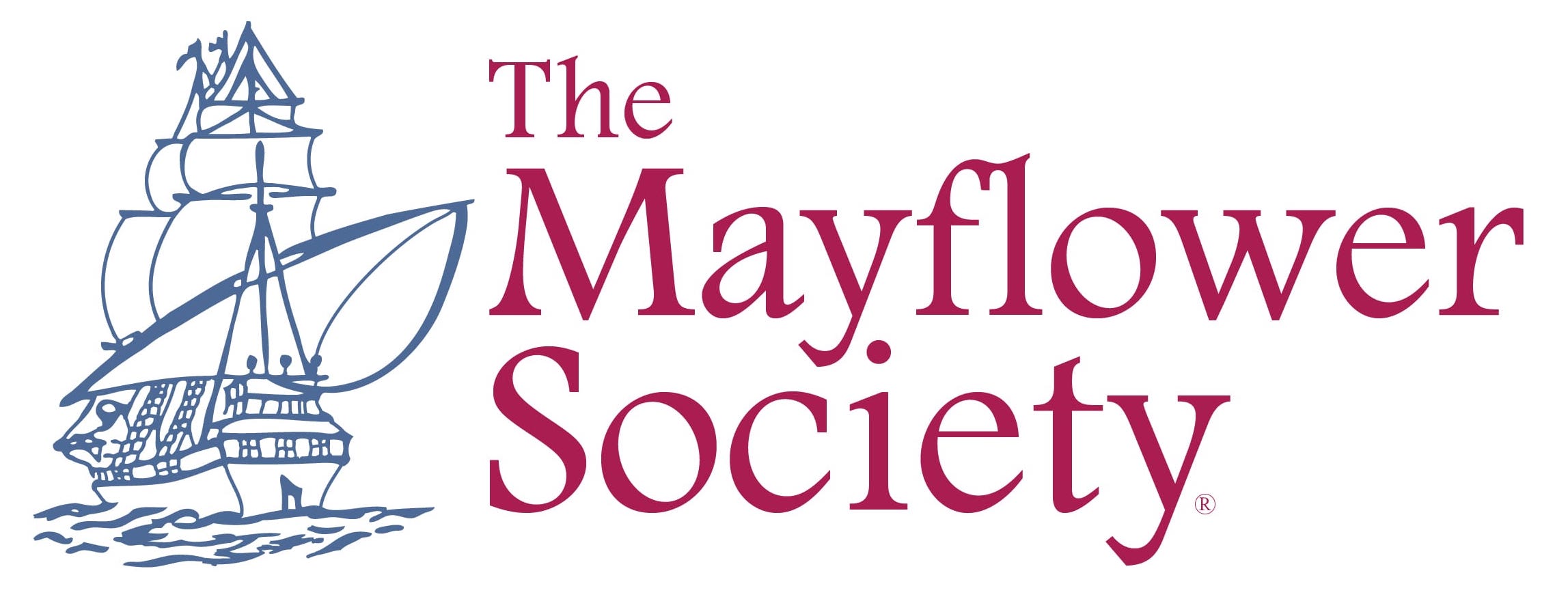
The Mayflower Voyage
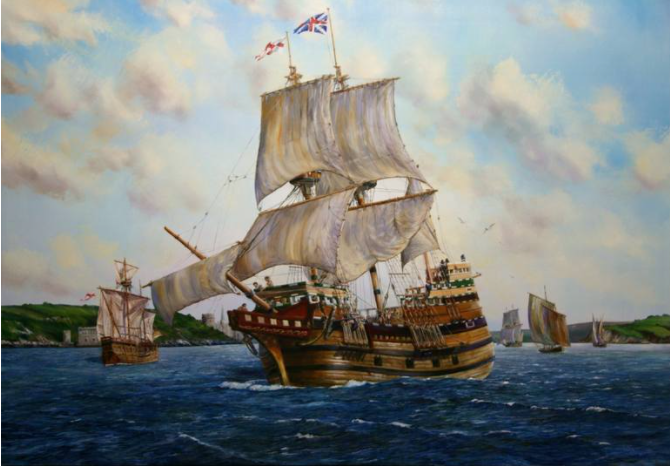
It is hard for us in this present age to imagine what it would be like not to know certain things – not know how wide the oceans were; – not to know how far Virginia was from Plymouth, England; – or from Plymouth, Massachusetts, for that matter; not to know, even, how far a ship would sail in a day or a week, and not to have any maps or charts of a good degree of accuracy for any country or any ocean on earth. All of this lack of knowledge was the situation 1620.
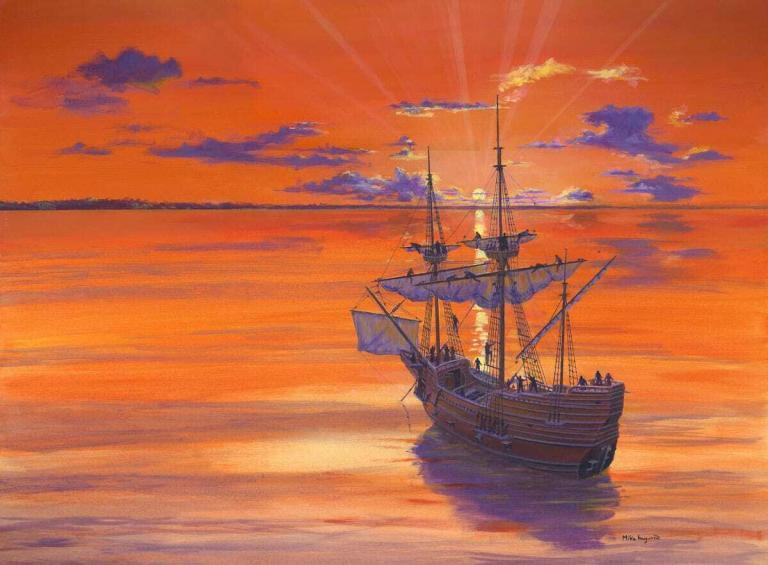
Now, of course, there was much sea-faring in 1620. Ships plied the English Channel, sailed up and down the coast of France and Spain and swarmed all over the Mediterranean. But this was mainly coastal, short voyage work. In any trip the length of time out sight of land was minimal. This is not to say that there were not trans-ocean voyages in the period. The gold trade between Spain and Mexico had flourished for years. The cost in lives and ships and cargo had been and continued to be terrific. The many recent treasure finds from sunken Spanish galleons in waters near Florida bear vivid witness to the awful costs of these many passages. These costs in men, ships and cargo were due in great degree to the ignorance of the crews and skippers and navigators. In those days the practitioners of the sea-faring art had no ability to determine accurately, on a day to day basis, their ship’s position or what dangers lurked.
So much for the state of the art in 1620. What do we find as to how many of these meager skills were possessed by Captain Jones and his crew aboard the Mayflower?
We know that Captain Jones was a part owner of the ship and had been Captain for several years. He had just returned from Spain, hauling a cargo of wine. He had traded at least once across the North Sea to Norway from Newcastle. He was probably as well suited to, and trained for, an Atlantic crossing as the average sea captain of the day. To understand just what is involved in making a crossing, whether back then or today, it is necessary to get a bit technical and describe some of the essentials of navigation and passage making in any age.
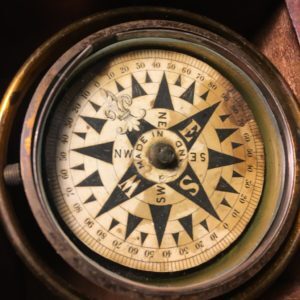
When out of sight of land, the navigator depends on several aids to keep his ship on course and to position her daily on the surface of the ocean. Then, as now, the first aid is the compass. With it he can shape his course steadily toward his destination. All of us know something about a compass, and how its north-seeking needle points to magnetic north. The discovery and use of the magnetic properties of ferrous compounds goes way, way back in time. One of the first references to a mariner’s compass is found in the writings of one Alexander Neckam, born in A.D. 1157. We are sure its use antedated this date by years and perhaps centuries.
The next aid is the traverse board . This is a kind of abacus and memo pad. A circle at the top of the board is divided by radii into the thirty-two points of the compass. Each of these radii has eight holes, evenly spaced out from the center, into which pegs can be fitted. The bottom of the board is divided by eight horizontal lines and these lines also have holes evenly spaced across their length for pegs. Then, as now, a steering watch was four hours long, divided into eight 30 minute glasses of time. At the turning of each glass (every thirty minutes), the quartermaster put a peg in the proper radius hole to represent the average course steered during the period and the proper glass number of the watch period.
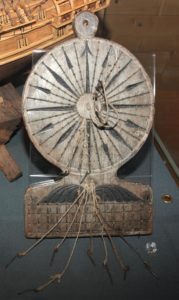
This sounds quite impressive, but the results were far from anything but rough guesses. They were at least better than no guess at all. So, with compass, traverse board and log-ship, the 1620 navigator kept his accompt book of daily positions – his dead reckoning positions. Even today, with much better compass, perfect timing devices, and excellent speedometers, the position of a ship at sea by dead reckoning may be off by a substantial mileage each day.
This leads us to the next aid the navigator must have. He must have a way of figuring his position from day to day by means independent of course or speed. The aid he uses to do this is an altitude measuring device with which he can determine the altitude of some heavenly body and, with suitable calculations, find from this measurement his location at sea. In 1620 the aids used were either an astrolabe or a Davis backstaff .
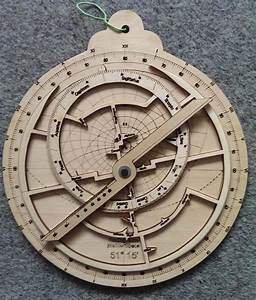
This is where Celestial Navigation comes into the picture. Celestial Navigation, in all its mathematical and astronomical theory, is rather complicated but its basic principal is simplicity itself. Poets have referred to the heavenly bodies – the sun, moon, stars and planets – as the “Lighthouses of the Sky” This poetic fancy happens to be strict, practical fact. Consider for a moment. We are on the revolving earth. It revolves from west to east, and this motion makes it appear to us that the sun and all other bodies rise in the East and set in the West. Imagine, if you will, a string running from the center of the earth to the center of a heavenly body. This string would cut the surface of the earth at a certain point at a certain time. This point is called the “GP” of the body. “GP” stands for “geographical position.” It keeps changing from moment to moment as the earth turns. Today the GP’s of fifty-seven navigational stars, four planets, the moon and the sun are listed in a Government publication issued annually and called the Nautical Almanac. This book lists these positions in terms of degrees North or South of the equator, and degrees West of an arbitrary line running through Greenwich, England. They are listed for every second of time of the year.
In 1620 no such handy volume existed. Tables of the “Declination of the Sun” for every day of the year were available, however. Declination is merely the astronomer’s name for latitude and refers to the latitude on the earth’s surface of the GP of the body. Now, remember a heavenly body moves westward in the sky rapidly, about 15 degrees an hour, but it moves slowly north or south. So a daily table of the sun’s declination is useful.
Let’s review a bit now. The aids available to Captain Jones in 1620 were the compass , the traverse board , the log ship and, of course, the second glass and hourglass. With these he did the best he could to keep his accompt book , or Log of daily dead reckoning position – his “DR.” He used his Davis backstaff or astrolabe to measure the altitude of the sun. Today he would use a sextant. This beautifully accurate instrument in the hands of a skilled observer is capable of measuring altitude angles to one six-hundredth of a degree. Captain Jones with his instrument would do well to get within a degree – some six hundred times less accurate – on board the heaving and pitching Mayflower !
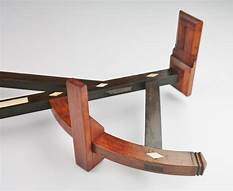
To do his best to keep from building up high cumulative errors in his dead reckoning accompt , Captain Jones practiced celestial navigation each day at high noon. High noon merely means that the sun is due north or due south of you, and is going from “rising” to “setting.” At this moment we say it is on your meridian – not A.M. or P.M. Captain Jones’s celestial navigation consisted of measuring the sun’s altitude at his best estimate of its highest point for the day.
This high point occurs at high noon (by a sun dial or compass). To make this measurement, the backstaff was probably used because it was a bit simpler on shipboard than an astrolabe. From the altitude of the sun, so obtained, and the declination for the day from the tables, Captain Jones could get his latitude by a simple calculation. We might mention here that Captain Allan Villiers carried a replica of a Davis backstaff on the voyage of Mayflower II and reported it quite useless for any meaningful accuracy. Even allowing Jones much greater accuracy than Villiers, due to more practice, it is doubtful if the latitudes obtained were much better than the DR figures which themselves were pretty awful by present day standards.
Now note that this bit of celestial observation only checked latitude. No attempt to obtain positions East or West of your departure was possible by celestial observations at that time. It would be more than a hundred years later before longitude could be found at sea.
We have mentioned the sun only as a method to obtain latitude. For centuries navigators had known that the altitude of the Pole Star, Polaris, roughly equaled the latitude of the observer. At the time of the Mayflower voyage, it is likely that Captain Jones felt he could get better results from observations of the sun. Of course, he might have observed either from time to time.
There is a whole set of circumstances in seventeenth century sailing which must not be overlooked. We must remember the life aboard a ship at those times– the almost unbelievable discomfort, the monotony, week after week after week, the cold, the wet, the poor food coupled with hard physical labor. This terrible environment made it practically impossible to exercise the careful judgment and carry out the accurate calculations which, then as now, are absolutely essential in the practice of navigation. There is no wonder that whole fleets of ships were sunk and wrecked on unfamiliar shores, and that a seaman’s life was hard and short in those far off times.
The Mayflower made history by carrying the Pilgrims to the New World. But never forget – SHE WAS ONE OF THE LUCKY ONES!
– November 1980 – VoL 46 No. 4
MayflowerHistory.com
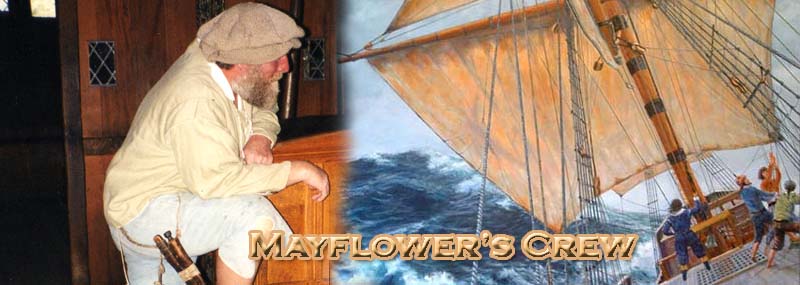
The Mayflower would have been crewed by about thirty men. Of those, only a handful can be identified with historical records.
Ship's Master, Christopher Jones The ship's master (the term "captain" was only used for military ships at this time) was Christopher Jones. He was born about 1570, the son of Christopher and Sybil Jones of Harwich, Essex, England. He lived in Harwich until about the age of 40, when he then moved to Rotherhithe, Surrey, England, a short distance from London on the river Thames. His first ship of record was called the Josian , named after his wife. He sold that ship about 1608, and purchased the Mayflower with three others. He had nine children, but most of them died in infancy. He was about fifty years old when he was hired to transport the Pilgrims to America onboard his ship.
Ship's Pilot and Master's Mate, John Clarke John Clarke had been a ship's pilot on a voyage to Jamestown, Virginia in 1611, in the fleet that brought Sir Thomas Dale to govern the colony. He lived and worked ferrying cargo in the bay for about 40 days, until a Spanish ship came into the harbor. He was taken prisoner, tied up, and sailed first to Havana, Cuba, and later to Malaga, Spain, where he would be repeatedly interrogated by Spanish authorities. After five years imprisonment, he was released to the English in 1616. He took a load of cattle to Jamestown again in 1618, and was then hired for the Mayflower 's voyage.
Master's Mate, Robert Coppin. Not much is known about Robert Coppin, other than he claimed to have been to New England on a previous voyage and claimed to have some experience whaling. He may have come from the vicinity of Harwich, and a man of that same name invested a small sum to purchase a share in the Virginia Company of London in 1609.
Cooper (Barrel-maker), John Alden. Twenty-one year old John Alden was hired in Southampton, England, where the Mayflower took on provisions, but he may also have originally been from Harwich, as there was an Alden family living there that was related, by marriage, to Master Christopher Jones. Alden's job was to build, repair and maintain the ship's barrels. This was a very important job, since everyone's food and drink were stored within those barrels. The Pilgrims' joint-stock company had agreed to allow him to decide whether he would stay in their Colony, or return to England. John Alden ultimately decided to stay.
Ship's Surgeon, Giles Heale. Giles Heale was born about 1595, and had just completed his apprenticeship in London as a Barber-Surgeon on 3 August 1619 with Edward Blanie. Just prior to the Mayflower's voyage, on 2 May 1620, Giles Heale filed his marriage intention to Mary Jarrett of St. Giles in the Fields. The voyage of the Mayflower was quite probably Giles Heale's first "real" job. Given that half the crew and half the passengers would ultimately die, he may have been quite unprepared for what ultimately played out. In February, during the height of the first winter at Plymouth, Mayflower passenger Isaac Allerton gifted him a book, Annotations Upon the Psalms by Henry Ainsworth. Giles Heale regifted the book to his wife Mary on 28 February 1621/2. The book still survives and is at the Library of Virginia in Richmond. Giles Heale also witnessed the February 1620/1 will of William Mullins. He returned to London after the voyage and took up residence at St. Anne Blackfriars, where a daughter Mary was baptized on 23 April 1623, and buried four days later. They had a son William baptized 11 March 1624/5 at St. John of Wapping, London, but he is buried 21 October 1625 in neighboring St. Mary Whitechapel. They had no more children. Heale was admitted to the lecture bills of the Barber Surgeons in 1631, and was taxed at Drury Lane in 1641 and 1646. In 1644, he and his wife were involved in a Chancery lawsuit over a debt owed them by William Chamberlain of London, esquire. He was buried 8 April 1653 at St. Giles in the Field, London, producing a will four days earlier that only mentioned his wife Mary.
Master Gunner. The master gunner was responsible for the maintenance and readiness of the ship's guns, powder, and canon. Though his name was not recorded, it is known that the Master Gunner went out on the expedition of 6 December 1620 exploring Cape Cod, where it was reported he was "sick unto death (but hope of trucking made him to go)." He died the first winter.
Ship's Carpenter. The ship's carpenter was responsible for stopping leaks, caulking, splicing masts, and fixing anything ship-related that broke or needed mending. He was responsible for maintaining his tools and supplies, including nails, cinches, hatchets, saws, and rudder iron. When the main beam of the Mayflower cracked during the middle of the voyage, the Master Carpenter made the repairs with a giant screw that the passengers happened to have with them. He also assisted in constructing the shallop that the Pilgrims had dismantled and stored betwixt the decks.
The Boatswain. The boatswain was responsible for the ship's rigging, rope, tackle, and sails, as well as the ship's anchors and the ship's longboat. William Bradford remembered that the Mayflower 's boatswain was "a proud young man, who would often curse and scoff at the passengers, but when he grew weak they had compassion on him and helped him." Despite that help, the boatswain died the first winter.
The four Quartermasters. The quartermasters were in charge of maintaining the cargo hold and setting and maintaining the shift and watch hours. The quartermasters were also responsible for fishing and maintaining the lines, hooks and harpoons. Though the names of the Mayflower 's quartermasters are unknown, it is known that three of the four of them died the first winter at Plymouth.
The Ship's Cook. The cook was responsible for preparing the meals for the crew, and maintaining the food supplies and the ship's cook room (typically located in the forecastle of the ship). The Mayflower 's cook also died the first winter at Plymouth.

- Join - It's Free
Great Migration: Passengers of the Higginson Fleet, 1629
« Back to Projects Dashboard
Project Tags
- Great Migration
- Higginson Fleet
Related Projects
- Great Migration: Passengers of the Abigail, 1628
- Great Migration: Passengers of the Abigail, 1635
- Great Migration: Passengers of the Angel Gabriel, 1635
- Great Migration: Passengers of the Anne & Little James, 1623
- Great Migration: Passengers of the Arbella, 1630
- Great Migration: Passengers of the Defence (Defiance), 1635
- Great Migration: Passengers of the Elizabeth, 1634 & 1635
- Great Migration: Passengers of the Fortune, 1621
- Great Migration: Passengers of the Griffin, 1634
- Great Migration: Passengers of the Handmaid, 1630
Top Surnames

The fourteenth trip of the Mayflower was part of the Higginson Fleet, leaving England Apr 24, 1629 for the Massachusetts Bay with MasterWilliam Pierce.
Six ships: George Bonaventure , Lyon , Lyon's Whelp , Four Sisters , Mayflower (14) , Pilgrim (4)
“Now in this year1629, a great company of people (The Higginson Fleet) of good rank, zeal, means and quality have made a great stock, and with six good ships in the months of April and May, they set sail from Thames for the Bay of the Massachusetts, otherwise called Charles River.
The fleet consisted of, the George Bonaventure of twenty pieces of ordnance; the Talbot nineteen; the Lion’s Whelp eight; the Mayflower fourteen; the Four sisters fourteen and the Pilgrim four, with 350 men women and children, also 115 head of cattle, as horses, mares, cows and oxen, 41 goats, some conies (rabbits), with all provision for household and apparel, 6 pieces of great ordnance for a fort, with muskets, pikes, corselets, drums, colors, and with all provisions necessary for a plantation for the good of man.”
(The True Travels, Adventures and Observations of Captain John Smith – London 1630)
John Endicott, in the ship Abigail , Henry Gauden, master, arrived at Salem September 6, 1628.
Shortly after Endicott’s arrival and the settlement of Salem there “came over from England several people at their own charge, and arrived at Salem”. (Higginson Fleet) There were the 350 passengers on the fleet of six ships listed above. Included in this fleet were the three brothers, Ralph, Richard and William Sprague. These three brothers, with several others, with Endicott’s permission traveled through the woods to the peninsula on which Charlestown is now located. The Town Records refer to this event and from them the following is quoted: “Amongst others that arrived at Salem at their own cost, were Ralph Sprague, with his brethren Richard and William, who with three or four more, by joint consent and approbation of Mr. John Endicott, Governor, did the same summer of Anno 1629, undertake a journey from Salem, and traveled the woods about twelve miles to the westward, and lighted of a place situate and lying on the north side of Charles River, full of Indians called Aberginians. Their old Sachem being dead, his eldest son, by the English called John Sagamore, was their chief, and a man naturally of a gentle and good disposition, by whose free consent they settled about the hill of the same place, by the said natives called Mishawum.”
The following is an excerpt from the first proceedings of the Sprague’s and their associates:
“The inhabitants yet: first settled in this place and brought it into the denomination of an English Towne, was in Anno 1629 as follows, viz: Ralph Sprague; Richard Sprague; William Sprague; John Meech; Simon Hoyte; Abraham Palmer; Walter Palmer; Nicholas Stower; John Stickline. Thomas Walford Smith yet lived here alone before. Mr. Graves who had charge of some, of the servants of the Company of Patentees with whom he built the great house this year for such of the said Company as are shortly to come over which afterwards became the Meeting house. And Mr. Bright Minister to the Companies Servants.”
“By whom it was jointly agreed and concluded that this place on the north side of Charles River, by the natives called Mishawum, shall henceforth from the name of the river, be called Charlestown, which was also confirmed by Mr. John Endicott, governor.”
From http://users.adelphia.net/~cousin.wes3/stower_stowers_history.htm
Higginson sources:
http://users.adelphia.net/~cousin.wes3/stower_stowers_history.htm
Add profiles to this project
Add collaborators to this project.
- © 2024 Geni.com
- US State Privacy Notice
- Code of Conduct
- World Family Tree
Oklahoma Society of Mayflower Descendants

The Coming of the Mayflower
N.C. Wyeth (1882–1945)
They were encountred many times with crosse winds, and mette with many feirce stormes, with which ye shippe was shroudly shaken...
–William Bradford
The Mayflower and Speedwell twice set sail from England and returned because the Speedwell leaked. After the second return, the Speedwell was deemed unseaworthy, although no specific leak was found. A significant reorganization of the voyage followed.
On September 6th, 1620, 102 passengers and 25-30 crew members crowded on board the Mayflower and set sail again, a month behind schedule. They were leaving behind some of the passengers and vital supplies and would be crossing the Atlantic Ocean at the height of the storm season.
The Mayflower was a modest merchant ship built to carry crew and cargo. It had no passenger cabins, beds, dining rooms, or toilets. It also had very little ventilation. The passengers stayed on the "gun deck," which measured about five and a half feet tall, preventing anyone taller from standing upright. At that time, all ships were cargo ships; the concept of passenger ships would not emerge for another two hundred years.
The 66-day voyage was eventful. A baby was born; a young passenger died; a main mast cracked and fell during a storm, casting doubt on the ship's fate until its repair; and a male passenger fell overboard, requiring a dramatic rescue. In addition, the seas were often stormy, and the relentlessly cold and wet passengers suffered from seasickness, scurvy, dehydration, and hunger.
On November 9th, the ship sighted American land, and the passengers rejoiced. However, as they approached the upper end of Cape Cod, they realized they were north of the area where King James had authorized them to settle. After deliberating with the shipmaster, the Mayflower changed direction to sail south along the coast to its intended destination.
Within a day, joy turned to terror as treacherous shallow waters and crashing waves threatened to splinter the ship. They could not continue south. Harsh winter weather was upon them, food and drink supplies were nearly gone, and passengers and crew were ill and dying. Having no choice, they reversed their course and sailed back to Cape Cod to look for a place to settle.

The Arrival of the Pilgrim Fathers
by Antonio Gisbert, c. 1864
DID YOU KNOW?
1. By the time the Pilgrims left England, they had already been living on the ship for over a month.
2. The Mayflower was a "sweet ship," used to haul wine, but her sweet aroma of spilled wine would have worn off quickly with so many seasick passengers aboard.
3. Ship Master Christopher Jones owned the Mayflower with three other investors.
4. In those days, navy ship commanders were called captains, and merchant ship commanders were called masters.
5. The Mayflower was better suited for short trips along the European coast than long voyages across the Atlantic Ocean.
6. Some of the Speedwell crew later confessed to a plot to abandon the voyage. Indeed, the ship made many successful voyages after its return.
7. The Pilgrims set sail four years after William Shakespeare died.
8. Beer was the main beverage, even for children, because it was cleaner than water.
9. At least two dogs sailed on the Mayflower : a Mastiff and an English Springer Spaniel.
10. A few lucky passengers slept in hammocks, but most slept on the deck floor.
11. The Pilgrims mostly stayed below on their windowless deck because the crew was afraid they would get swept overboard.
12. The passengers had to relieve themselves in buckets on the ship.
13. One sailor told the seasick pilgrims he couldn't wait to throw their dead bodies overboard and keep their belongings. Ironically, he was the first to die and be buried at sea.
14. Very few women had traveled across the Atlantic to North America before.
15. There were eighteen women onboard. All were married, and three were in their last trimester of pregnancy.
16. John Howland got swept overboard during a storm, yet miraculously grabbed onto a rope in the water and held on long enough to be rescued with a boat hook.
17. The passengers ate salted meat and "hardtack," a dry biscuit, at most meals.
18. One of the mischievous Billlington boys fired off his father's musket near a barrel of gunpowder and started a fire aboard ship. Luckily no harm was done.
19. The baby born at sea was named Oceanus.

IMAGES
VIDEO
COMMENTS
The voyage. The 1621 voyage of the Fortune was the second English ship sent out to Plymouth Colony by the Merchant Adventurers investment group, which had also financed the 1620 voyage of the Pilgrim ship Mayflower. The Fortune was 1/3 the size of the Mayflower, displacing 55 tons. The Master was Thomas Barton.
Mayflower was an English sailing ship that transported a group of English families, known today as the Pilgrims, from England to the New World in 1620. After 10 weeks at sea, Mayflower, with 102 passengers and a crew of about 30, reached what is today the United States, dropping anchor near the tip of Cape Cod, Massachusetts, on November 21 [O.S. November 11], 1620.
The Mayflower was a merchant ship that carried 102 passengers, including nearly 40 Protestant Separatists, on a journey from England to the New World in 1620.
Mayflower. The Mayflower at sea; hand-coloured woodcut. Some of the Pilgrims were brought from Holland on the Speedwell, a smaller vessel that accompanied the Mayflower on its initial departure from Southampton, England, on August 15, 1620. When the Speedwell proved unseaworthy and was twice forced to return to port, the Mayflower set out alone ...
Bradford became the second governor of Plymouth Colony after the death of John Carver (although often, incorrectly, identified as the first) and its chronicler. Bradford's Of Plymouth Plantation is considered a literary and historical classic, providing a first-hand account of the voyage of the Mayflower and establishment of the Plymouth Colony.
Her Maiden Voyage. Mayflower II set sail from Plymouth, England on April 20, 1957 with a crew of thirty-three men under the command of acclaimed Captain Alan Villiers. As they neared Massachusetts shores, Mayflower II ran into a violent squall. No one aboard had experience with handling a 17th-century vessel in inclement weather.
The Mayflower is the name of the cargo ship that brought the Puritan separatists (known as pilgrims) to North America in 1620 CE. It was a type of sailing ship known as a carrack with three masts with square-rigged sails on the main and foremast, three decks (upper, gun, and cargo), and measured roughly 100 feet (27 m) long and 25 feet (7 m) wide. The pilgrim passengers, and those not ...
The Mayflower set sail on 16th September 1620 from Plymouth, UK, to voyage to America. But its history and story start long before that. Its passengers were in search of a new life - some seeking religious freedom, others a fresh start in a different land. They would go on to be known as the Pilgrims and influence the future of the United ...
The Mayflower was hired in London, and sailed from London to Southampton in July 1620 to begin loading food and supplies for the voyage--much of which was purchased at Southampton.The Pilgrims were mostly still living in the city of Leiden, in the Netherlands. They hired a ship called the Speedwell to take them from Delfshaven, the Netherlands, to Southampton, England, to meet up with the ...
The Mayflower passengers are listed after the below interactive map which shows where each of the Pilgrims originally came from and where they lived. ... the last stop before the voyage to America and home to the iconic Mayflower Steps. ... Second son of John Turner Francis Eaton, non-separatist Sarah Eaton, Francis' wife
Mayflower in Plymouth Harbor, painting by William Halsall (1882). This is a list of the passengers on board the Mayflower during its trans-Atlantic voyage of September 6 - November 9, 1620, the majority of them becoming the settlers of Plymouth Colony in Massachusetts.Of the passengers, 37 were members of a separatist Puritan congregation in Leiden, The Netherlands (also known as Brownists ...
The Mayflower was a merchant ship that usually carried goods such as wine, but its most famous cargo was the group of pilgrims destined to settle in Plymouth. The ship first set sail in August 1620 alongside another merchant ship called the Speedwell. After the Speedwell sprouted a leak, both ships returned to port, and all passengers crammed ...
Pilgrims boarding the Mayflower for their voyage to America. The Pilgrim's arduous journey to the New World technically began on July 22, 1620, when a large group of colonists boarded a ship ...
The other passengers aboard the Mayflower were servants and independent settlers hired by the Merchant Adventurers Company who financed the voyage and the prospective colony. However, it was the elders of the separatist congregation who governed the new colony in its formative years and their religious beliefs shaped how it was run.
The Mayflower Voyage. For the passengers and crew who boarded the Mayflower some four centuries ago, the odds were firmly stacked against them as they looked to cross the Atlantic to start a new life.. By the time the group set sail from Plymouth on 16 September 1620, many of them had experienced religious persecution; trouble with the law (including time in prison for some); betrayal from ...
Navigation in 1620: The. Mayflower. Was One of the Lucky Ones. From Diamond Jubilee Edition 27. Robert A. Harper. Presented at a meeting of the Myles Standish Colony of the Florida Society, in Naples, Florida. W hen I first thought of discussing the art of navigation in 1620 and how Captain Christopher Jones of the Mayflower probably employed ...
Below is a complete list of all Mayflower passengers, along with a link to each for further information. John and Eleanor Billington, and sons John and Francis. Stephen and Elizabeth (Fisher) Hopkins and children Constance, Giles and Damaris; son Oceanus was born during the voyage. William and Susanna (Jackson) White, and son Resolved (son ...
Fortune. (Plymouth Colony ship) In the fall of 1621 the Fortune was the second English ship destined for Plymouth Colony in the New World, one year after the voyage of the Pilgrim ship Mayflower. Financed as the Mayflower was by Thomas Weston and others of the London-based Merchant Adventurers, Fortune was to transport thirty-five settlers to ...
Giles Heale was born about 1595, and had just completed his apprenticeship in London as a Barber-Surgeon on 3 August 1619 with Edward Blanie. Just prior to the Mayflower's voyage, on 2 May 1620, Giles Heale filed his marriage intention to Mary Jarrett of St. Giles in the Fields. The voyage of the Mayflower was quite probably Giles Heale's first ...
The fourteenth trip of the Mayflower was part of the Higginson Fleet, leaving England Apr 24, 1629 for the Massachusetts Bay with MasterWilliam Pierce.. Six ships: George Bonaventure, Lyon, Lyon's Whelp, Four Sisters, Mayflower (14), Pilgrim (4) "Now in this year1629, a great company of people (The Higginson Fleet) of good rank, zeal, means and quality have made a great stock, and with six ...
The Mayflower and Speedwell twice set sail from England and returned because the Speedwell leaked. After the second return, the Speedwell was deemed unseaworthy, although no specific leak was found. A significant reorganization of the voyage followed. On September 6th, 1620, 102 passengers and 25-30 crew members crowded on board the Mayflower and set sail again, a month behind schedule.
Mayflower II is a reproduction of the 17th-century ship Mayflower, celebrated for transporting the Pilgrims to the New World in 1620. The reproduction was built in Devon, England during 1955-1956, in a collaboration between Englishman Warwick Charlton and Plimoth Patuxet (at the time known as Plimoth Plantation), a living history museum.The work drew upon reconstructed ship blueprints held ...
In 1956 Warwick Charlton completed his quest to have a second Mayflower built and sail from England to America. Now 60 plus years later, Warwick's son Randal and Hamilton's John Henley have ...